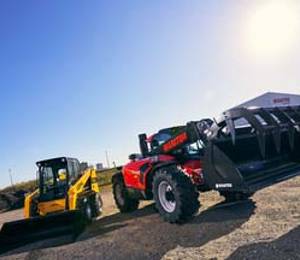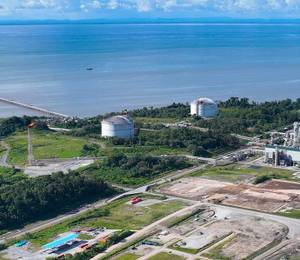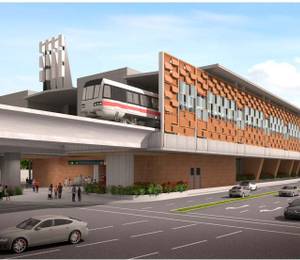To ensure that roads remain functional over the long term, they are increasingly in need of structural rehabilitation. To meet this requirement, Wirtgen has developed the high-performance W 380 CRi cold recycler.
The cold recycling process – which at a minimum recycles the surface and base course material – has been used globally, and demand for this solution is expected to continue to grow in the future. In the in-place cold recycling process, the asphalt surface is removed either in full or in layers, depending on the level of damage, by a recycling train operating across the entire width of the pavement in a single pass, mixed with binding agents on site, and then paved again immediately. At the heart of this recycling train are tracked cold recyclers, such as the Wirtgen W 380 CRi.
Providing working widths of 3,200, 3,500 and 3,800 mm, the W 380 CRi cold recycler can mill roads between 100- and 300-mm-deep in most applications. At the same time, it granulates the material and transforms it into a new, homogeneous material mixture by adding binding agents such as cement, bitumen emulsion or foamed bitumen.
The W 380 CRi features a mixing capacity of up to 800 t/hr. It can feed enormous quantities of recycled material to a Vögele paver via its swivel-mounted and height-adjustable discharge conveyor at the rear. This makes it possible to complete extremely long stretches of road in a single day of work. Final compaction is carried out by Hamm tandem and tyre rollers.
Wirtgen’s tracked cold recyclers use the down-cut process when recycling, in which the milling and mixing rotor rotates in sync. This method is believed to have become an essential part of day-to-day recycling operations, as it allows to selectively vary the particle size of the material being processed – especially in the case of fragile, thin, old asphalt roads.
Durable foamed bitumen mixture
Wirtgen pointed out that roads rehabilitated using the cold recycling process have to meet the same durability requirements as roads designed and built using conventional methods. For this reason, the company has created solutions to guarantee that the rehabilitation measures will be cost-effective and sustainable even before they are carried out. As a result, the recycler offers the capability to define the ideal composition of the RAP, and also to directly analyse its quality and properties using samples in triaxial and splitting tensile strength tests. The quality of the foamed bitumen can also be precisely defined in the materials laboratory prior to starting the rehabilitation project.
Cold recycling, particularly with foamed bitumen, is gaining popularity with road authorities and construction companies, said Wirtgen. With this method, the foamed bitumen is processed in-place with the existing building material. The newly produced bituminous mix is known as BSM (bitumen-stabilised material). After final compaction, it shows a long-term and extremely high load-bearing capacity.
Viewed from a long-term perspective, BSM has another advantage, added Wirtgen. The foamed bitumen mixed in leads to selective adhesion within the cold recycling layer and thus prevents cracking. The permanent layers prepared in this way form the perfect foundation for the final asphalt layer with considerably reduced thickness.
Cost-effective design ‘with less binders’
The significant potential for energy savings during material processing is also a highlight of the cold recycling process. The raw materials do not have to be dried or heated, so 10-12 l of fuel can be saved per ton in comparison to conventional rehabilitation methods, explained Wirtgen. By almost completely reusing the surface course, the need to transport building materials can be reduced by up to 90%. At the same time, companies can cut resource consumption by 90% and completely eliminate the need to dispose of materials. This results in substantially reduced fuel consumption and lower CO2 emissions.
Most importantly, the cold recycling design minimises the use of binders by up to 50% – the area with the greatest potential savings, since binders are still the biggest cost factor in road rehabilitation, revealed Wirtgen. Thanks to the special properties of BSM, the cold recycling technology allows for very low costs over the entire life of the roads.
As the RAP is immediately recycled and the associated logistics are extremely lean, in-place cold recycling means that projects can be completed much quicker than with conventional rehabilitation methods.
According to Wirtgen, the entire series of machines required for the rehabilitation process can fit in the width of just one lane. On two-lane roads, for example, the work can be performed across the width of a single lane, while traffic can be routed along the other side of the roadway past the construction site in one lane. Beyond normal working hours, the entire road width is usually available, as the freshly recycled pavement can temporarily be used immediately after compaction has been completed.
In addition to the W 380 CRi (775 kW; EU Stage 5 / US Tier 4f) and W 380 CR (708 kW; EU not regulated / US Tier 2) models, the new generation of Wirtgen recyclers includes the W 240 CRi (775 KW; EU Stage 5 / US Tier 4f) and W 240 CR (708 KW; EU not regulated / US Tier 2).
The W 240 CRi and W 240 CR cold recyclers can be equipped with integrated Vögele AB 375 T variable screeds and have a maximum working width of 2,350 mm.
The four cold recyclers can also be used as efficient, high-performance milling machines employing the traditional up-cut process. Thanks to powerful engines and an impressive conveyor belt capacity, they achieve high removal rates at a maximum milling depth of up to 350 mm – for instance, when removing complete asphalt packages or for large-scale rehabilitation measures such as on motorways or airport runways.















